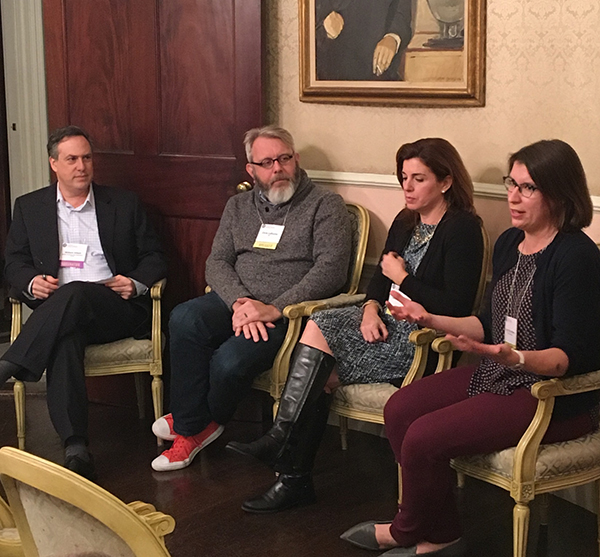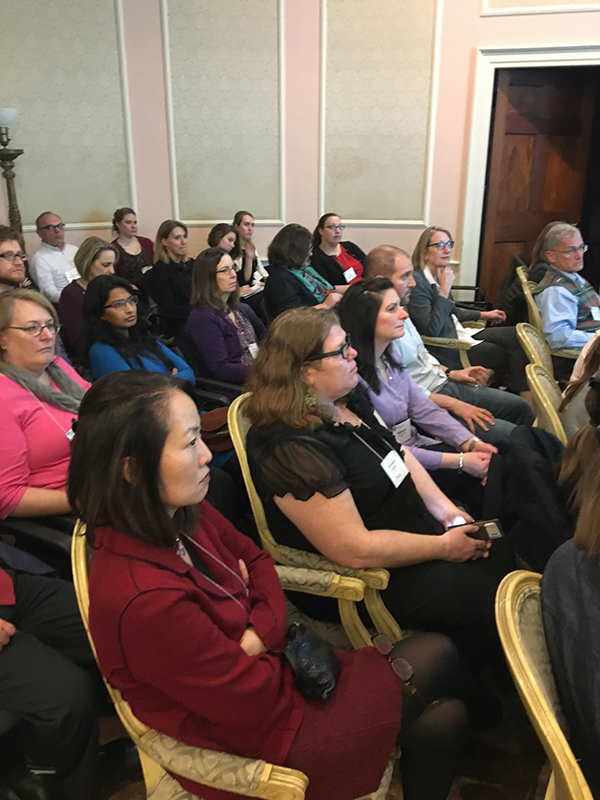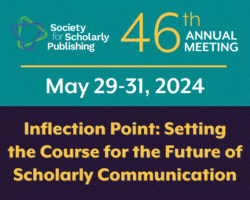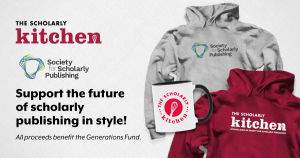
Panelists from the Boston regional even included, (left to right) William Albert, moderator,
Bentley; Christopher LaRoche, speaker, MIT; Kate Lawrence, speaker, EBSCO; Amy Deschenes,
speaker, Harvard (Photo Credit: Colleen Myers)
The Society for Scholarly Publishing (SSP) held a regional programming event on the important and evolving topic of User Experience on November 16, 2016 at the American Meteorological Society headquarters in Boston. The event consisted of a lecture and presentation from Chris LaRoche, User Experience Consultant at MIT, followed by a lively panel discussion. The panel discussion was moderated by William Albert, Executive Director, Bentley University User Experience Center, who was joined by LaRoche; Kate Lawrence, Vice President, User Research at EBSCO Information Services; and Amy Deschenes, Senior UX Consultant for Harvard University.
Several additional regional programming events are set to take place in early December in other cities. On December 7 Philadelphia, PA will host a panel discussion titled “Open Access in Education: Open Educational Resources (OERs) and the Open Syllabus Project in the Context of Scholarly Publishing”. The event will be hosted by the American Association for Cancer Research (AACR), 615 Chestnut St. and run from 5:30 p.m. to 7:30 p.m. An additional event will follow in Durham, NC on December 8 where a panel discussion titled “Fostering Innovation in Scholarly Communication” is scheduled to be held at the Research Square offices, 601 West Main St., Suite 102. Registration for both events remains open.
LaRoche started by showing a fascinating diagram of what feeds into User Experience (UX) analysis – everything from cognitive science, branding, technical communication, accessibility, human factor engineering and psychology, among others. Practitioners in the field typically come from one of these backgrounds, and many consider themselves “generalists” with knowledge spanning many different fields. Only recently have specialist UX programs been available at the college level. To cite a local example, Bentley University offers both a UX certificate and a master’s degree in Human Factors in Information Design. LaRoche also mentioned the Boston UXPA – a Boston user group focused on UX which holds an annual local conference. The good news for those interested in UX is that the field is definitely growing and there are a lot of jobs available.
Although it may be perceived as a field that just came about recently, LaRoche explained that the roots of UX actually date back to World War II, when it was necessary to design airplane instrumentation to avoid overwhelming the brain with too much information. Planes were actually crashing not because of mechanical problems, but because of human error based on information overload. Although some people today might think of UX as applying mostly to software and web design, in actuality, both consumer and medical device manufacturers pay a lot of attention to UX, particularly to reduce medical errors.

Full House: SSP Boston Regional Event, November 2016, American Meteorological Society
(Photo Credit: Colleen Myers)
LaRoche divided UX into three areas: Research, Design and Evaluation. Depending on the organization, more emphasis may be placed on any one or all of these three areas. Chris noted that asking users for design ideas is not usually the most appropriate approach, as evidenced by “The Homer”, a car designed by Homer Simpson on the popular Simpsons television program, which proved to be a flop. Accessibility is another very important aspect of UX, and improving accessibility often improves it for all users, not just those who have special needs.
The follow-on panel discussion picked up on how UX is implemented in organizations. All stressed that having users interact directly with the software or product is key – not just talking about what a user might like to see. There are many UX evaluation methods that can be employed, and although outside stakeholders might request doing a survey or focus group (because these are methods they are familiar with), those might not be the best methods to answer the business or research question. UX practitioners are knowledgeable about the best method to apply to each situation. In some organizations, UX practitioners are also involved in designing and implementing solutions to any issues uncovered in the evaluations, and in other organizations the UX people pass along information to others, such as product designers. The UX group may be called back in to evaluate the changes that product designers have made, leading to a continual improvement cycle.
Networking was a key component of the evening. Before and after the presentation and panel SSP members and non-member were able to mingle over appetizers and beverages.
By Caroline Webber, Sr. Business System Analyst, Aries Systems



Join the Conversation
You must be logged in to post a comment.